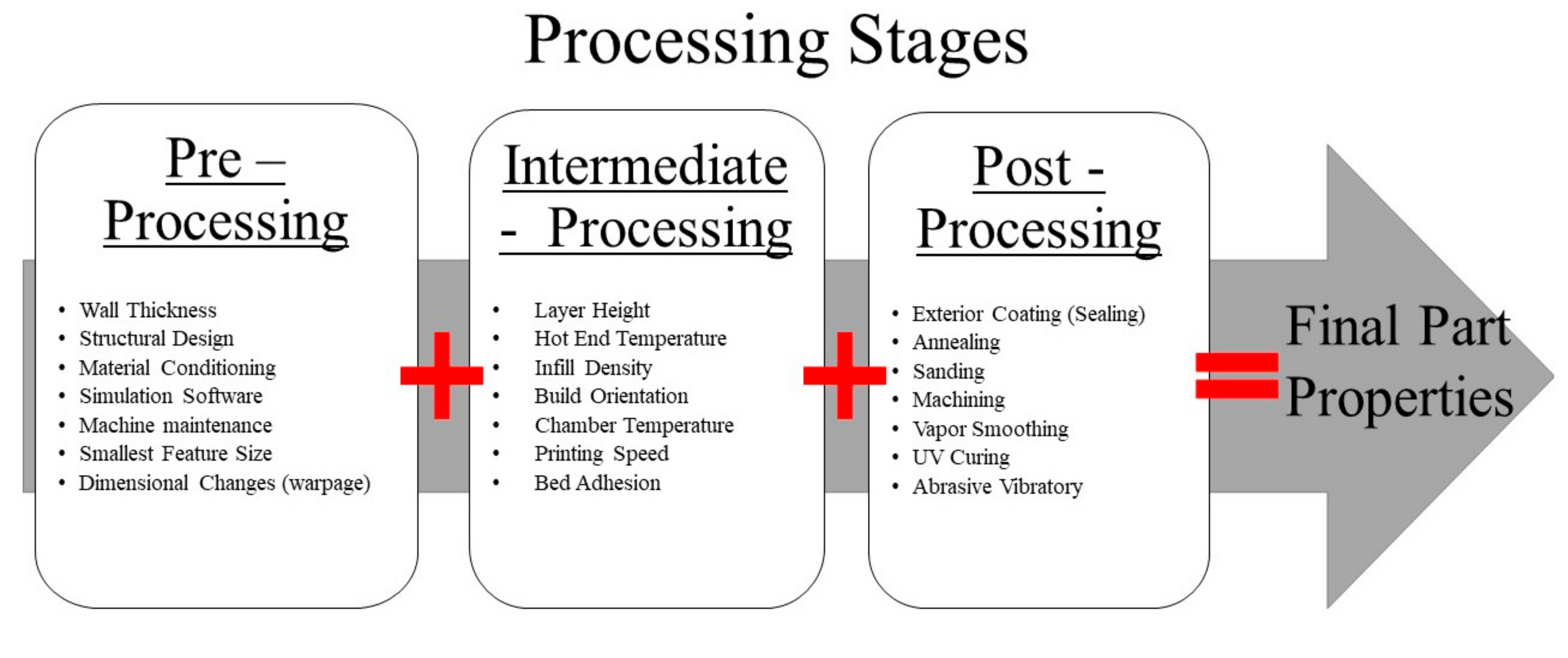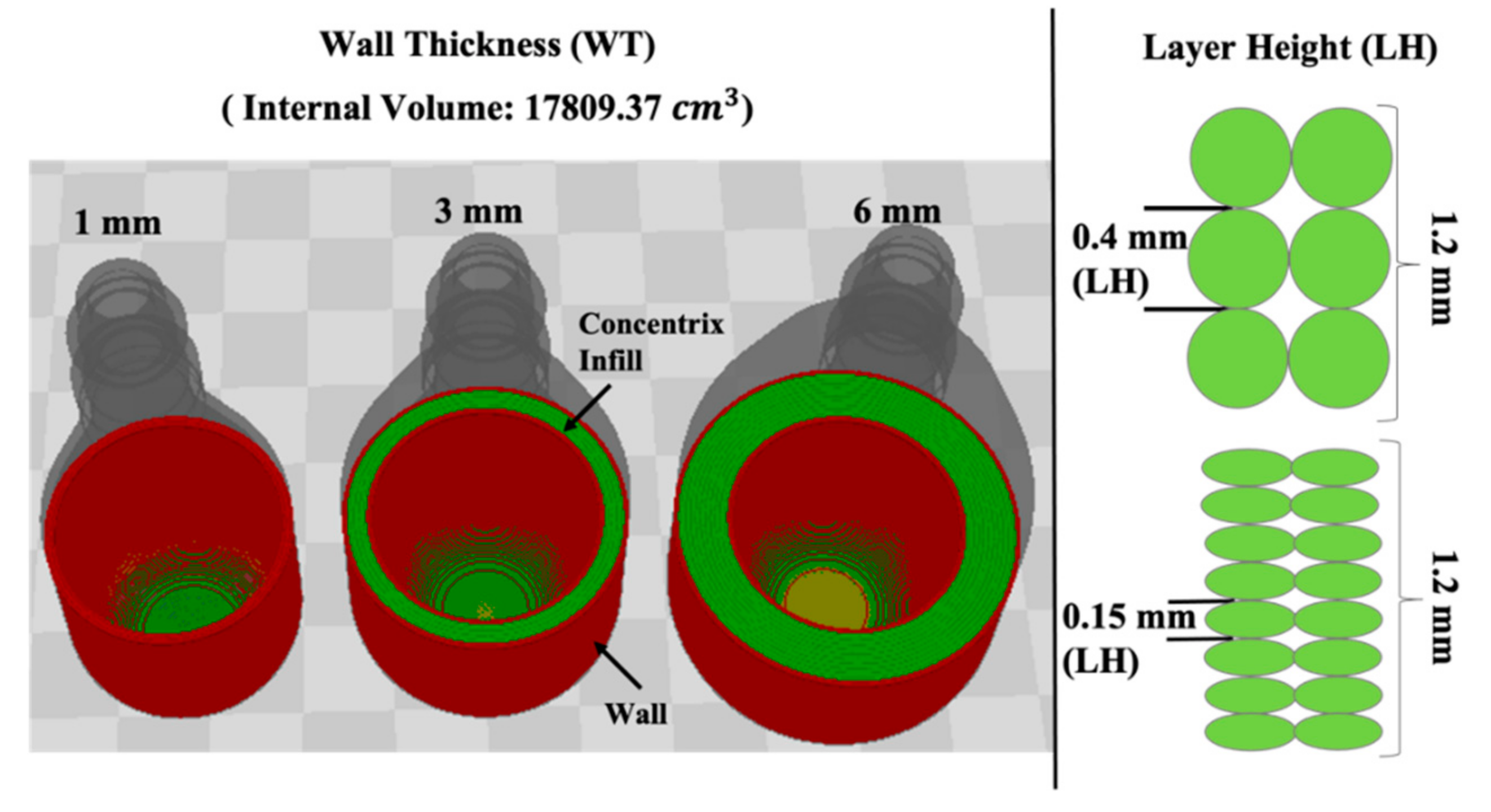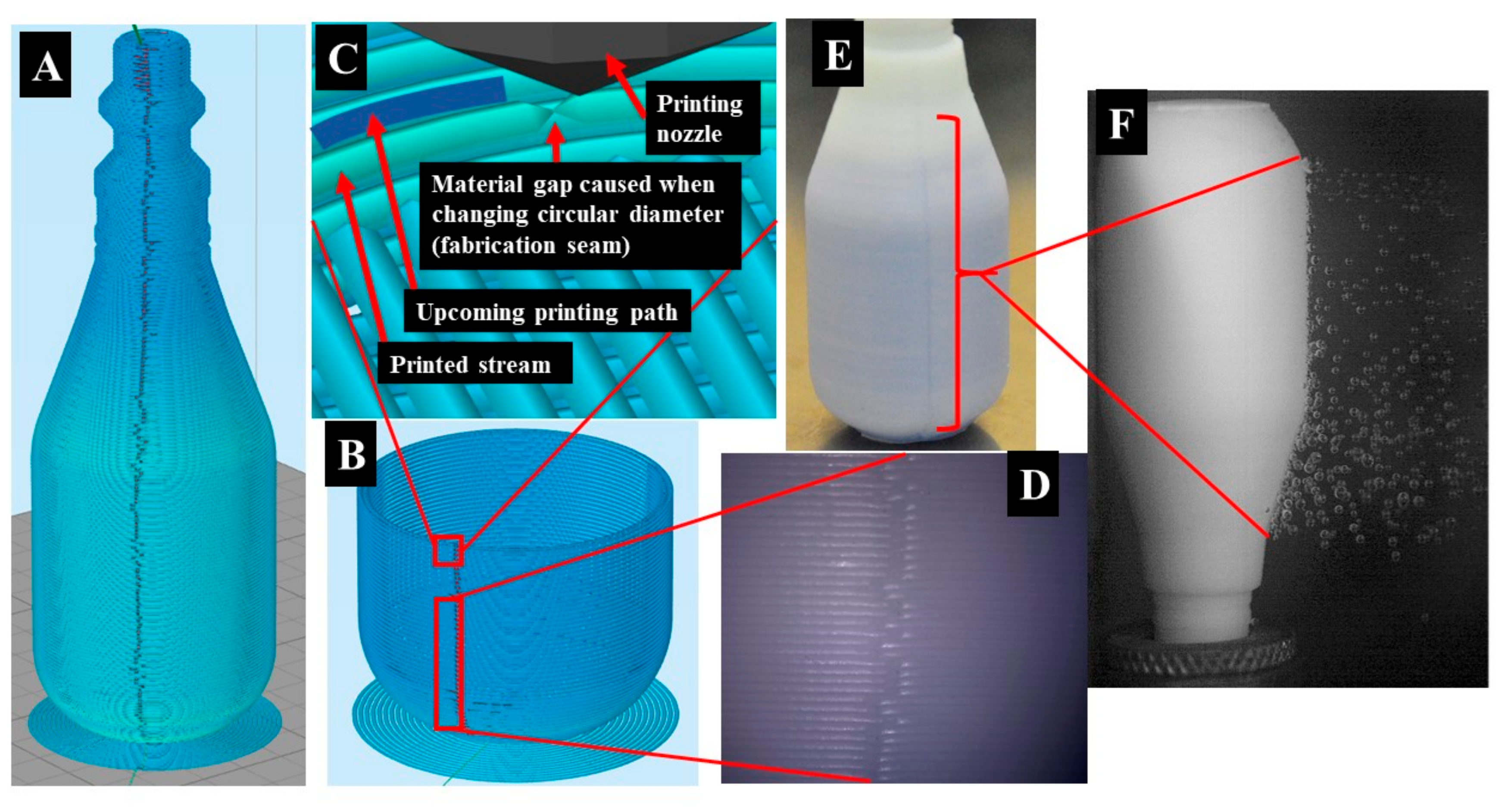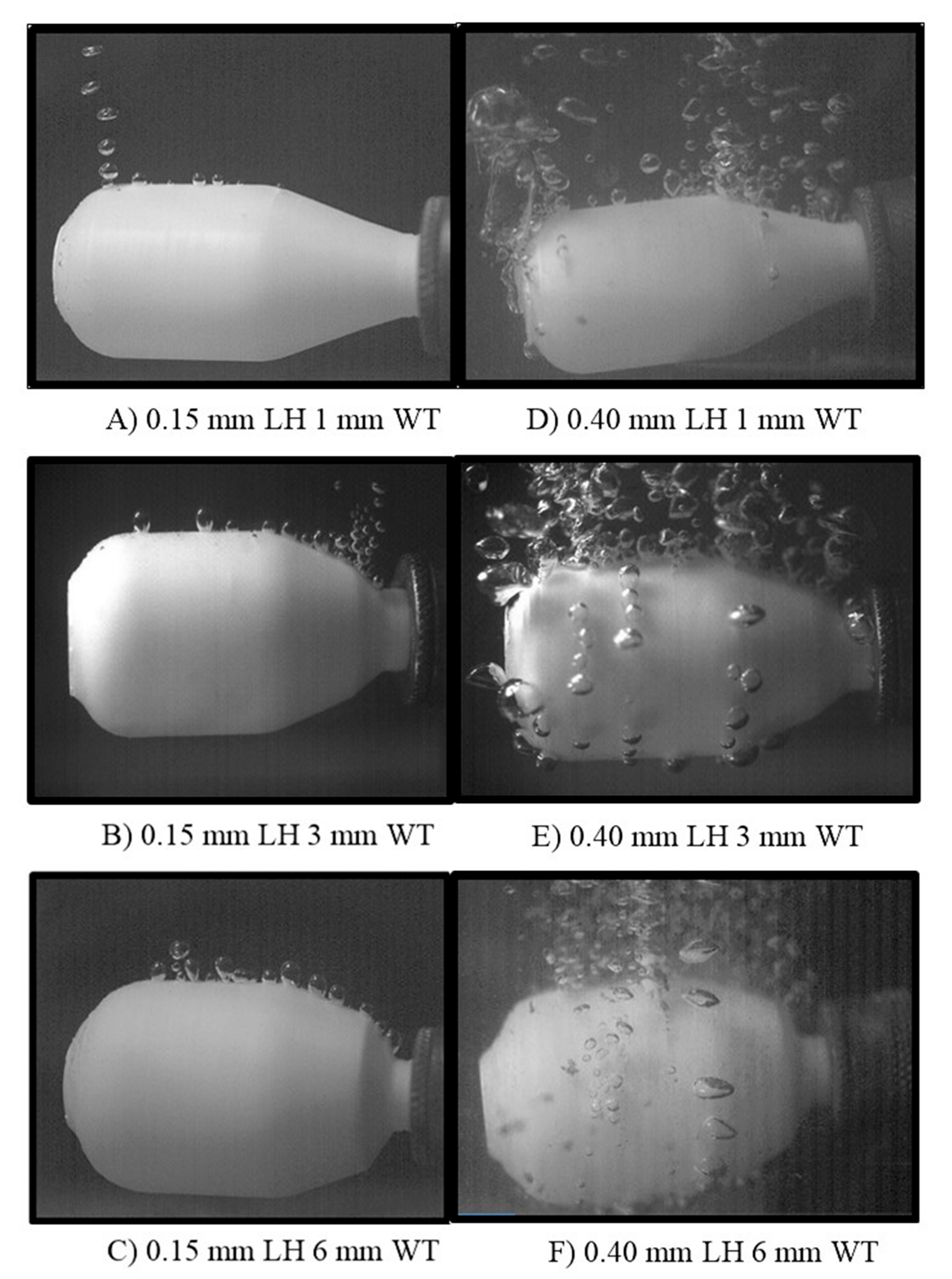Porosity Reducing Processing Stages of Additive Manufactured Molding (AMM) for Closed-Mold Composite Fabrication
Abstract
:1. Introduction
2. Materials and Methods
2.1. Vessel Design and Testing
2.1.1. Additive Manufacturing of Pressure Vessels
2.1.2. Leak Testing Procedure
2.2. Mold Design and Testing
2.2.1. Additive Manufacturing of Mold/Tooling
2.2.2. Mold Post-Processing
2.3. Composite Design and Testing
2.3.1. Manufacturing of Fiber-Reinforced Composites
2.3.2. Non-Destructive and Destructive Evaluation
3. Results and Discussion
3.1. Simulation Results
3.2. Pressure Vessel Results
3.3. Mold Results
3.4. Composite Results
3.4.1. Composite Processing
3.4.2. Non-Destructive Results
3.4.3. Destructive Results
4. Conclusions
Author Contributions
Funding
Acknowledgments
Conflicts of Interest
References
- Composites Market Global Forecast to 2024|MarketsandMarkets. Available online: https://www.marketsandmarkets.com/Market-Reports/composite-market-200051282.html (accessed on 17 April 2020).
- Centea, T.; Grunenfelder, L.K.; Nutt, S.R. A review of out-of-autoclave prepregs – Material properties, process phenomena, and manufacturing considerations. Compos. Part Appl. Sci. Manuf. 2015, 70, 132–154. [Google Scholar] [CrossRef]
- Harshe, R. A Review on Advanced Out-of-Autoclave Composites Processing. J. Indian Inst. Sci. 2015, 95, 207–220. [Google Scholar]
- Zhakeyev, A.; Wang, P.; Zhang, L.; Shu, W.; Wang, H.; Xuan, J. Additive Manufacturing: Unlocking the Evolution of Energy Materials. Adv. Sci. 2017, 4, 1700187. [Google Scholar] [CrossRef] [Green Version]
- Large-Scale 3D Printing Supports Innovation in Construction, (n.d.). Available online: https://www.additivemanufacturing.media/blog/post/large-scale-3d-printing-supports-innovation-in-construction (accessed on 5 December 2018).
- Periard, D. Printing Embedded Circuits. Available online: http://utw10945.utweb.utexas.edu/Manuscripts/2007/2007-43-Periard.pdf (accessed on 15 October 2018).
- Asprone, D.; Auricchio, F.; Menna, C.; Mercuri, V. 3D printing of reinforced concrete elements: Technology and design approach. Constr. Build. Mater. 2018, 165, 218–231. [Google Scholar] [CrossRef]
- Wu, P.; Wang, J.; Wang, X. A critical review of the use of 3-D printing in the construction industry. Autom. Constr. 2016, 68, 21–31. [Google Scholar] [CrossRef] [Green Version]
- Ni, Y.; Ji, R.; Long, K.; Bu, T.; Chen, K.; Zhuang, S. A review of 3D-printed sensors. Appl. Spectrosc. Rev. 2017, 52, 623–652. [Google Scholar] [CrossRef]
- Nayak, A.; Jain, P.K. Additive Manufacturing in Civil Engineering. Civ. Eng. Res. J. 2017, 1, 1–4. [Google Scholar] [CrossRef]
- Lušić, M.; Schneider, K.; Hornfeck, R. A Case Study on the Capability of Rapid Tooling Thermoplastic Laminating Moulds for Manufacturing of CFRP Components in Autoclaves. Procedia CIRP 2016, 50, 390–395. [Google Scholar] [CrossRef] [Green Version]
- Türk, D.-A.; Ebnöther, A.; Zogg, M.; Meboldt, M. Additive Manufacturing of Structural Cores and Washout Tooling for Autoclave Curing of Hybrid Composite Structures. J. Manuf. Sci. Eng. 2018, 140, 105001. [Google Scholar] [CrossRef] [Green Version]
- Kunc, V.; Lindahl, J.; Dinwiddie, R.; Post, B.; Love, L.; Matlack, M.; Fahey, R.L., Jr.; Hassen, A.A. Investigation of In-autoclave Additive Manufacturing Composite Tooling. In Proceedings of the CAMX Conference, Anaheim, CA, USA, 26–29 September 2020; Available online: https://www.ornl.gov/publication/investigation-autoclave-additive-manufacturing-composite-tooling (accessed on 20 October 2020).
- Hassen, A.A.; Lindahl, J.; Chen, X.; Post, B.; Love, L.; Kunc, V. Additive Manufacturing of Composite Tooling Using High Temperature Thermoplastic Materials. Available online: https://www.researchgate.net/profile/Ahmed_Arabi_Hassen/publication/324442073_ADDITIVE_MANUFACTURING_OF_COMPOSITE_TOOLING_USING_HIGH_TEMPERATURE_THERMOPLASTIC_MATERIALS/links/5acdfa790f7e9b18965745f7/ADDITIVE-MANUFACTURING-OF-COMPOSITE-TOOLING-USING-HIGH-TEMPERATURE-THERMOPLASTIC-MATERIALS.pdf (accessed on 19 February 2019).
- Stratasys. Composite Tooling with FDM 3D Printing. Available online: https://www.stratasys.com/tooling/composite-tooling (accessed on 20 September 2018).
- Arafath, A.R.A.; Vaziri, R.; Poursartip, A. Closed-form solution for process-induced stresses and deformation of a composite part cured on a solid tool: Part II—Curved geometries. Compos. Part Appl. Sci. Manuf. 2009, 40, 1545–1557. [Google Scholar] [CrossRef]
- Ryan, I.; Christopher, W. Design and manufacture of a Formula SAE intake system using fused deposition modeling and fiber-reinforced composite materials. Rapid Prototyp. J. 2010, 16, 174–179. [Google Scholar]
- Jonsson, M.; Nordin, O.; Kron, A.L.; Malmström, E. Thermally expandable microspheres with excellent expansion characteristics at high temperature. J. Appl. Polym. Sci. 2010, 117, 384–392. [Google Scholar] [CrossRef]
- Pommer, C.; Sinapius, M. A Novel Approach to Monitoring the Curing of Epoxy in Closed Tools by Use of Ultrasonic Spectroscopy. Sensors 2017, 18, 96. [Google Scholar] [CrossRef] [PubMed] [Green Version]
- Ning, F.; Cong, W.; Hu, Z.; Huang, K. Additive manufacturing of thermoplastic matrix composites using fused deposition modeling: A comparison of two reinforcements. J. Compos. Mater. 2017, 51, 3733–3742. [Google Scholar] [CrossRef]
- Ning, F.; Cong, W.; Hu, Y.; Wang, H. Additive manufacturing of carbon fiber-reinforced plastic composites using fused deposition modeling: Effects of process parameters on tensile properties. J. Compos. Mater. 2017, 51, 451–462. [Google Scholar] [CrossRef]
- Gordeev, E.G.; Galushko, A.S.; Ananikov, V.P. Improvement of quality of 3D printed objects by elimination of microscopic structural defects in fused deposition modeling. PLoS ONE 2018, 13, e0198370. [Google Scholar] [CrossRef]
- Balani, S.B.; Chabert, F.; Nassiet, V.; Cantarel, A. Influence of printing parameters on the stability of deposited beads in fused filament fabrication of poly(lactic) acid. Addit. Manuf. 2019, 25, 112–121. [Google Scholar] [CrossRef] [Green Version]
- Casavola, C.; Cazzato, A.; Moramarco, V.; Pappalettera, G. Residual stress measurement in Fused Deposition Modelling parts. Polym. Test. 2017, 58, 249–255. [Google Scholar] [CrossRef]
- Villalpando, L.; Eiliat, H.; Urbanic, R.J. An Optimization Approach for Components Built by Fused Deposition Modeling with Parametric Internal Structures. Procedia CIRP 2014, 17, 800–805. [Google Scholar] [CrossRef] [Green Version]
- Erokhin, K.S.; Gordeev, E.G.; Ananikov, V.P. Revealing interactions of layered polymeric materials at solid-liquid interface for building solvent compatibility charts for 3D printing applications. Sci. Rep. 2019, 9, 1–14. [Google Scholar] [CrossRef]
- Spencer, J.; Cobb, R.; Dickens, P. Vibratory Finishing of Stereolithography Parts. Available online: https://repositories.lib.utexas.edu/bitstream/handle/2152/65034/1993-03-Spencer.pdf?sequence=2&isAllowed=y (accessed on 14 December 2017).
- Ramos, L.P.; Uddin, N.; Al-Hamdan, A.; Kirby, J.; Salama, T.; Waldron, C. Development of Vacuum Assisted Resin Transfer Molding (VARTM) Method for the Repair and Strengthening of Concrete Structures. Available online: https://search.proquest.com/docview/1366759300?pq-origsite=gscholar&fromopenview=true (accessed on 27 February 2019).
- Stark, M.S. Improving and Understanding Inter-Filament Bonding in 3D-Printed Polymers. Available online: https://trace.tennessee.edu/cgi/viewcontent.cgi?article=3021&context=utk_chanhonoproj (accessed on 25 February 2019).
- Kariz, M.; Kuzman, M.K.; Sernek, M. Adhesive bonding of 3D-printed ABS parts and wood. J. Adhes. Sci. Technol. 2017, 31, 1683–1690. [Google Scholar] [CrossRef]
- Wu, W.; Geng, P.; Li, G.; Zhao, D.; Zhang, H.; Zhao, J. Influence of Layer Thickness and Raster Angle on the Mechanical Properties of 3D-Printed PEEK and a Comparative Mechanical Study between PEEK and ABS. Materials 2015, 8, 5834–5846. [Google Scholar] [CrossRef] [PubMed]
- McIlroy, C.; Olmsted, P.D. Disentanglement effects on welding behaviour of polymer melts during the fused-filament-fabrication method for additive manufacturing. Polymer 2017, 123, 376–391. [Google Scholar] [CrossRef] [Green Version]
- Sun, Q.; Rizvi, G.M.; Bellehumeur, C.T.; Gu, P. Effect of processing conditions on the bonding quality of FDM polymer filaments. Rapid Prototyp. J. 2008, 14, 72–80. [Google Scholar] [CrossRef]
- Garg, A.; Bhattacharya, A.; Batish, A. Chemical vapor treatment of ABS parts built by FDM: Analysis of surface finish and mechanical strength. Int. J. Adv. Manuf. Technol. 2017, 89, 2175–2191. [Google Scholar] [CrossRef]
- Chohan, J.S.; Singh, R.; Boparai, K.S.; Penna, R.; Fraternali, F. Dimensional accuracy analysis of coupled fused deposition modeling and vapour smoothing operations for biomedical applications. Compos. Part B Eng. 2017, 117, 138–149. [Google Scholar] [CrossRef]
- Singh, R.; Singh, S.; Singh, I.P.; Fabbrocino, F.; Fraternali, F. Investigation for surface finish improvement of FDM parts by vapor smoothing process. Compos. Part B Eng. 2017, 111, 228–234. [Google Scholar] [CrossRef]
- Lalehpour, A.; Barari, A. Post processing for Fused Deposition Modeling Parts with Acetone Vapour Bath. IFAC-PapersOnLine 2016, 49, 42–48. [Google Scholar] [CrossRef]
- ASTM D3039/D3039M-17. Standard Test Method for Tensile Properties of Polymer Matrix Composite Materials; ASTM International: West Conshohocken, PA, USA, 2017; Available online: www.astm.org (accessed on 20 October 2020).









| Input | Layer Height (mm) | 0.15 | 0.40 | ||||
|---|---|---|---|---|---|---|---|
| Wall Thickness (mm) | 1 | 3 | 6 | 1 | 3 | 6 | |
| Output | Number of Layers | 501 | 514 | 534 | 187 | 192 | 200 |
| Printing Time (minutes) | 103 | 113 | 152 | 39 | 43 | 57 | |
| Internal volume (cm3) | 17,809.37 | ||||||
Publisher’s Note: MDPI stays neutral with regard to jurisdictional claims in published maps and institutional affiliations. |
© 2020 by the authors. Licensee MDPI, Basel, Switzerland. This article is an open access article distributed under the terms and conditions of the Creative Commons Attribution (CC BY) license (http://creativecommons.org/licenses/by/4.0/).
Share and Cite
Pollard, M.; Tran, P.; Dickens, T. Porosity Reducing Processing Stages of Additive Manufactured Molding (AMM) for Closed-Mold Composite Fabrication. Materials 2020, 13, 5328. https://doi.org/10.3390/ma13235328
Pollard M, Tran P, Dickens T. Porosity Reducing Processing Stages of Additive Manufactured Molding (AMM) for Closed-Mold Composite Fabrication. Materials. 2020; 13(23):5328. https://doi.org/10.3390/ma13235328
Chicago/Turabian StylePollard, Marquese, Phong Tran, and Tarik Dickens. 2020. "Porosity Reducing Processing Stages of Additive Manufactured Molding (AMM) for Closed-Mold Composite Fabrication" Materials 13, no. 23: 5328. https://doi.org/10.3390/ma13235328





